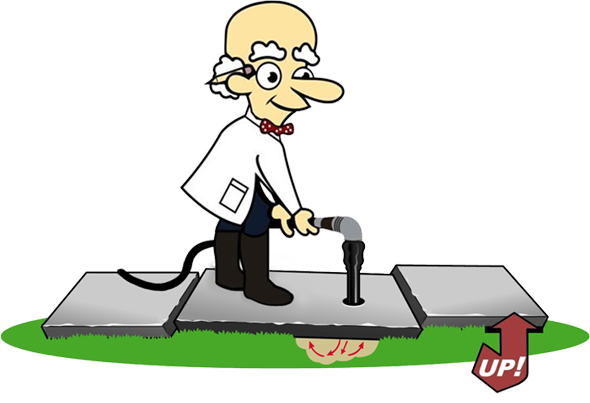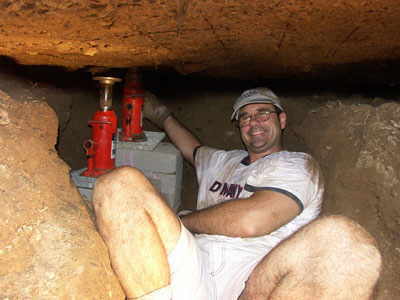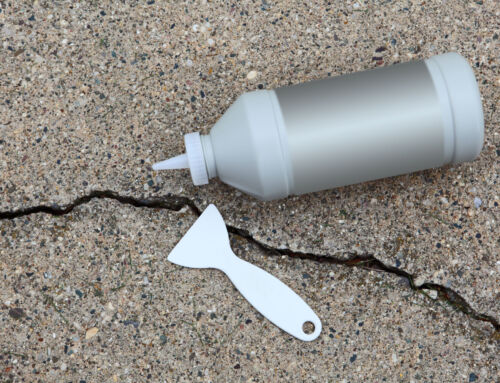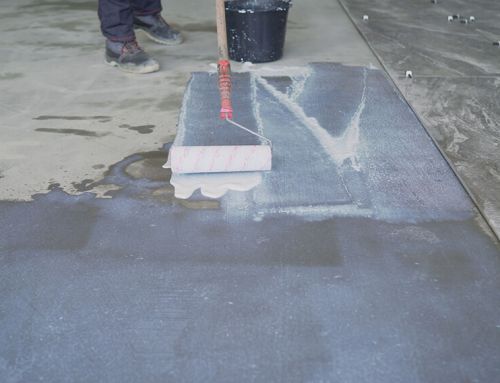IN THIS ARTICLE
Learn why voids form under concrete slabs, how to fix them, and which repair solution is right for your property.
Concrete slabs are used in driveways, sidewalks, patios, garages, pool decks, and other parts of a home or property. They provide solid, flat surfaces that support people, vehicles, and sometimes even buildings.
But over time, the ground underneath these slabs can shift, settle, or wash away. When that happens, a void forms — a space between the concrete and the soil. That gap might not be visible at first, but it weakens the slab. If not fixed, it can crack, sink, or collapse.
We’ve worked on many concrete repair projects where voids caused serious problems. Some clients only noticed a small dip in the concrete. Others had entire sections start to cave in. In every case, filling the void properly was the key to preventing worse damage.
In this guide, we’ll explain what causes voids under concrete slabs, how to spot them, and which repair options actually work. We’ll also talk about long-term solutions to keep voids from coming back.
What Is a Void Under a Concrete Slab?
A void is just an empty space beneath the concrete that shouldn’t be there. Concrete needs solid support from the ground. When that support disappears, the slab has nothing to rest on. Over time, it may crack or sink because it can no longer hold its own weight evenly.
Sometimes, these voids are small. Other times, they stretch across large sections of a driveway or pool deck. We’ve even seen cases where raccoons or groundhogs made things worse by digging tunnels beneath the slab.
Signs You Might Have a Void
Here are some warning signs we look for:
- Hollow sounds when tapping on the concrete
- Cracks, especially ones that get worse over time
- Uneven or sunken spots
- Water pooling on the surface
- Gaps along the edge where the slab meets soil or structures
- Small animals seen burrowing around slab edges
If you notice one or more of these, there’s a good chance a void has formed underneath.
What Causes Voids Under Concrete Slabs?
We’ve seen several common causes when inspecting homes in New Jersey and Eastern Pennsylvania:
1. Soil Erosion from Water
Water is the number one cause of voids. When water runs under a slab from poor drainage or a plumbing leak, it slowly washes soil away. Over months or years, this creates a gap. Heavy rains or melting snow speed up the process.
We’ve fixed many driveways where the only real problem was a broken downspout or gutter. That small issue sent water flowing under the slab for years.
2. Poor Compaction During Construction
Before pouring concrete, the soil underneath should be packed tightly. If the builders rushed the job or didn’t use the right tools, the soil settles later. That leaves space under the slab that turns into a void.
This is very common in newer developments or DIY jobs where corners were cut.
3. Organic Material Breaking Down
Sometimes, old tree roots, mulch, or buried vegetation decay under the slab. As they break down, they leave behind soft areas or small voids. These can grow over time.
4. Rodents or Burrowing Animals
In some cases, animals like moles, chipmunks, or even skunks create voids by digging under slabs. This happens most often with older patios or walkways near bushes or sheds.
Why You Need to Fix It
If you leave the void alone, it gets worse. Here’s what can happen:
- Cracking: The unsupported slab may crack under pressure.
- Sinking: Part of the slab might sink, creating trip hazards.
- More erosion: Water keeps flowing through the void, making it bigger.
- Costlier repairs: Fixing a small void now costs much less than replacing a broken slab later.
The longer you wait, the more damage you’ll see. We always tell clients: catching it early saves money.
How to Fix Voids Under Concrete
There are a few proven ways to fill the space under a slab and support the concrete again. Here’s what we recommend, based on our experience:
1. Slab Jacking (Mudjacking)
This is one of the most common and cost-effective options. It’s what we use in most jobs unless there’s a specific reason not to.
Here’s how it works:
- We drill small holes in the concrete.
- Then, we pump a slurry (a mix of water, cement, sand, and sometimes limestone) into the holes.
- The mixture flows into the void, filling it up.
- As it builds pressure, it lifts the slab back to its proper level.
- We plug the holes and clean up.
Pros:
- Affordable
- Long-lasting
- Eco-friendly (uses natural materials)
- Good for driveways, sidewalks, patios, garage floors
Cons:
- Takes longer to cure (foot traffic OK after a few hours, vehicles after 24–48 hours)
We’ve used this on hundreds of jobs. It holds up well and gives clients peace of mind.
2. Polyurethane Foam Injection
This method uses a lightweight, expanding foam instead of a cement mix. It’s pumped into the void, expands quickly, and hardens in minutes.
Pros:
- Fast drying (can walk or drive on slab within 1 hour)
- Requires smaller holes
Cons:
- More expensive
- Chemical-based material (can raise environmental or safety concerns)
- Harder to remove if something goes wrong
- Not a long term solution
As professionals with over 25 years of experience in this field, we generally recommend mudjacking for residential and commercial concrete leveling projects due to its reliability and cost.
3. Compaction Grouting
This is a heavy-duty repair solution. We inject thick grout deep into the soil under the void, not just into the empty space. The pressure compacts the loose soil and stabilizes everything.
Pros:
- Strong, permanent support
- Good for large structures or major soil problems
Cons:
- Expensive
- Requires special equipment
- Not necessary for most residential concrete
We usually recommend this only if there’s serious soil instability, like under warehouse slabs or commercial buildings.
4. Drainage Correction
If water is the cause of your void, and you don’t fix the drainage, the problem will come back.
Here’s what professionals often do:
- Regrade the soil around the slab
- Extend downspouts away from the home
- Add French drains
- Seal foundation cracks
- Repair broken sprinkler or plumbing lines
These are small changes, but they make a big difference.
5. Crack Sealing and Waterproofing
Once the slab is supported again, it’s important to address any cracks or open joints to prevent water from getting back in and causing future issues.
While we don’t handle sealing ourselves, we often recommend that homeowners or a qualified contractor apply a flexible sealant afterward, especially in areas exposed to rain or runoff.
How to Prevent Voids Under Your Concrete Slabs in the Future
You can avoid most void problems with simple maintenance:
- Improve drainage: Make sure water flows away from concrete, not toward it.
- Seal joints and cracks: Don’t let water sneak through surface gaps.
- Watch for signs: A small crack or low spot might be the early warning.
- Don’t overload slabs: Parking heavy vehicles on thin concrete can make it settle.
- Keep gutters and downspouts clear: Overflowing water can wash away soil.
We check our own properties every spring and fall. A quick inspection now can save you thousands later.
Final Thoughts
Voids under concrete slabs are more common than you might think. Left untreated, they can lead to cracking, sinking, and costly replacements. But with the right repair method, most voids can be safely and affordably fixed.
We’ve helped homeowners all over New Jersey and Eastern Pennsylvania restore their concrete surfaces with slab jacking and other trusted methods. If you suspect a void under your driveway, sidewalk, pool deck, or garage, don’t wait.
Let’s take a look and give you an honest opinion. No upselling. No pressure.
Just solid advice from people who fix concrete for a living.
Call Concrete Chiropractor® today to schedule a free evaluation.
Frequently Asked Questions
How do I know if there’s a void under my concrete?
Listen for hollow sounds when you tap it. Look for dips, cracks, or gaps at the edges. If it sounds empty or feels soft, call a pro to inspect it.
Can I fill the void myself with gravel or foam?
Maybe, but it’s not always effective. DIY fixes don’t lift the slab or fully fill the void. You may just delay the problem.
How long does mudjacking last?
With proper drainage and soil, we’ve seen mudjacking repairs last 10–15 years or more. Some never need another fix.
Will this fix cracks in the slab?
It supports the slab, but cracks may still need to be sealed separately.
What if animals are digging under the slab?
We can repair the void and recommend ways to deter animals, such as burying mesh or using deterrent sprays.
- How We Raised a Sunken Concrete Walkway in Sewell, NJ - November 20, 2025
- Carbon Fiber Foundation Repair: All You Need to Know - November 20, 2025
- 5 Common Causes of Concrete Porch Collapse (and How to Prevent It) - November 20, 2025








